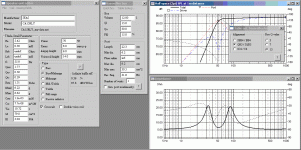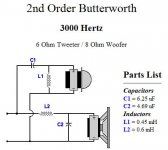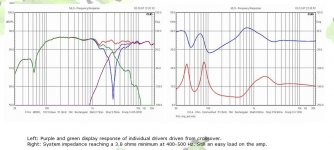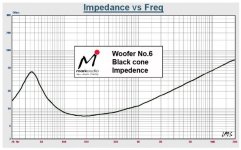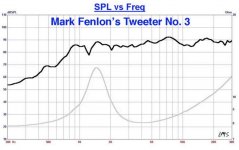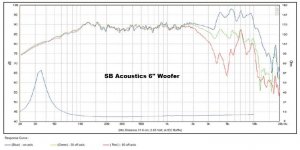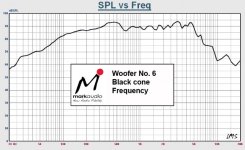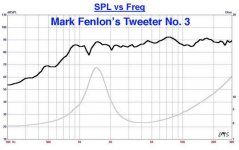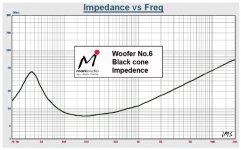The crosssover can be one of the major contributors too the impedance characteristic. Often a big bump in impedance at the XO, and reactive components that increase the phase angle.
This is of particular concern with a GC as they are at their very best with a nice flat, benign load.
The 1st one you point at, the M4, looks to have quite a simple XO -- a cap and a resistor for the tweeter -- which is pretty easy on the load. The M5 doesn't actually have any data. These kits also come with MDF flat-pak boxes. There is quite a bit of opportunity to make a better speaker for the same money by sourcing material & building your own box.
I'm partial to FR speakers so if i was on Oz i'd gravitate towards these guys. Darcher Audio
The preference for something 8 ohms to best suit your high voltage PD amp would give an opportunity to look at one of the twin driver CHR-70 or EL70 designs. The 8 ohm FR125SR is no slouch either althou some find a bit of assistance on the top nice. For that i like the ApexJr audax tweeter (the M4 looks to use a clone of it). Steve bought a ton of them (surplus) for a very "aggressive" price. Scroll down to Apex Jr Tweeter. 1.5 to 1.8 uF cap is just about perfect. At that size it makes no sense but to get a poly cap.

dave
This is of particular concern with a GC as they are at their very best with a nice flat, benign load.
The 1st one you point at, the M4, looks to have quite a simple XO -- a cap and a resistor for the tweeter -- which is pretty easy on the load. The M5 doesn't actually have any data. These kits also come with MDF flat-pak boxes. There is quite a bit of opportunity to make a better speaker for the same money by sourcing material & building your own box.
I'm partial to FR speakers so if i was on Oz i'd gravitate towards these guys. Darcher Audio
The preference for something 8 ohms to best suit your high voltage PD amp would give an opportunity to look at one of the twin driver CHR-70 or EL70 designs. The 8 ohm FR125SR is no slouch either althou some find a bit of assistance on the top nice. For that i like the ApexJr audax tweeter (the M4 looks to use a clone of it). Steve bought a ton of them (surplus) for a very "aggressive" price. Scroll down to Apex Jr Tweeter. 1.5 to 1.8 uF cap is just about perfect. At that size it makes no sense but to get a poly cap.

dave
Wow, thanks for the detailed responses everybody. I will have a good look through the links provided before asking more questions.
I didn't even know of Darcher Audio, they're even in Tasmania which is a bonus for me.
Ah yes, I did come across the Recession Buster kits which is what initially made me think as to whether the LSK kits were really worth the money. I may still consider buying one after pricing out some local options. I plan on ordering no later than a week from now if no unforeseen events pop up.
Damn, those Apex Jr tweeters are priced very aggressively!
Thank you very much again for getting me started, I wouldn't of had a chance finding all these resources in such a small amount of time.
Cheers.
I didn't even know of Darcher Audio, they're even in Tasmania which is a bonus for me.
Ah yes, I did come across the Recession Buster kits which is what initially made me think as to whether the LSK kits were really worth the money. I may still consider buying one after pricing out some local options. I plan on ordering no later than a week from now if no unforeseen events pop up.
Damn, those Apex Jr tweeters are priced very aggressively!
Thank you very much again for getting me started, I wouldn't of had a chance finding all these resources in such a small amount of time.
Cheers.
If I were to purchase speakers from Darcher Audio, what would people here recommend? They don't seem to stock the brands that I commonly see popping up in this forum (Vifa, Peerless, Seas).
For me to purchase the RB3 kit from the US, it would cost me $408 delivered to my door (120USD for shipping). Then I will have to build a case, buy ports, speaker terminals etc...
Rather than me spending more than what a M5 LSK kit would cost me, is it feasible for me to build something of similar quality for less? No more than $400 or even less? I'm a full time uni student so spending a bit less now would suit my circumstances better, also as these are my first DIY speakers, I'd like to keep costs down a bit as this is all a huge learning curve for me atm.
Thanks
For me to purchase the RB3 kit from the US, it would cost me $408 delivered to my door (120USD for shipping). Then I will have to build a case, buy ports, speaker terminals etc...
Rather than me spending more than what a M5 LSK kit would cost me, is it feasible for me to build something of similar quality for less? No more than $400 or even less? I'm a full time uni student so spending a bit less now would suit my circumstances better, also as these are my first DIY speakers, I'd like to keep costs down a bit as this is all a huge learning curve for me atm.
Thanks
From Darcher, the SB 6" woofers + the HiVi K1 tweeter are probably a good conventional 2 way combo;
also worth looking at are the CSS SDX7 woofer + a fullranger, either CSS or Mark audio, Planet10 has experience of these I beleive???
also worth looking at are the CSS SDX7 woofer + a fullranger, either CSS or Mark audio, Planet10 has experience of these I beleive???
also worth looking at are the CSS SDX7 woofer + a fullranger, either CSS or Mark audio, Planet10 has experience of these I beleive???
Oh yes :^)
A statement design in the works, Alpair7eN + 4 SDX7eN per side, but broadly based on the concepts we used in Tysen.
SDX7 is going to push you over your budget probably. Any good midbass will do the job. Care should be taken with efficiency if you plan to tackle a passive XO. Another thread just started with SDX7 xoed to FR125.
dave
Building speakers is not cheap but you can get a good bang for buck. Depends on how much bass you expect as generally the more bass extension, the more expensive.
These are good starting speakers so as an exercise check out how much these would cost to build compared to the RB3.
Troelsgravesen VifaPL14WJ + XT25TG
Troelsgravesen SEAS 5INCH Look at the CA15RLY version
SB Acoustics EKA
You could always contact Dan at Darcher as he may have some suggestions using drivers he supplies.
I had a design in the 2-way reference thread that was well received but the drivers are now defunct..... P13WH-00-08 + D27TG-35-06. It only used 3 crossover parts so was cheap to build. Still use mine but have a Scan Speak tweeter.
For reference only.... read from here:
http://www.diyaudio.com/forums/multi-way/25590-diyaudio-reference-speaker-project-9.html#post1005310
http://www.diyaudio.com/forums/multi-way/25590-diyaudio-reference-speaker-project-10.html#post1040262
You can find drivers at good prices on ebay. I picked up a pair of new M22WR-09-08 for much less than my trade price for 1. You occasionally can get a fully built DIY speaker for a song as they have little resale value. I picked up one where the parts were about 20% of the RRP and got the seller to send the parts only.
These are good starting speakers so as an exercise check out how much these would cost to build compared to the RB3.
Troelsgravesen VifaPL14WJ + XT25TG
Troelsgravesen SEAS 5INCH Look at the CA15RLY version
SB Acoustics EKA
You could always contact Dan at Darcher as he may have some suggestions using drivers he supplies.
I had a design in the 2-way reference thread that was well received but the drivers are now defunct..... P13WH-00-08 + D27TG-35-06. It only used 3 crossover parts so was cheap to build. Still use mine but have a Scan Speak tweeter.
For reference only.... read from here:
http://www.diyaudio.com/forums/multi-way/25590-diyaudio-reference-speaker-project-9.html#post1005310
http://www.diyaudio.com/forums/multi-way/25590-diyaudio-reference-speaker-project-10.html#post1040262
You can find drivers at good prices on ebay. I picked up a pair of new M22WR-09-08 for much less than my trade price for 1. You occasionally can get a fully built DIY speaker for a song as they have little resale value. I picked up one where the parts were about 20% of the RRP and got the seller to send the parts only.
Hi rabbitz.
Funnily enough I did try to price up what was essentially the RB3 kit here so as to save on shipping. Lets just say that they are priced very attractively, even with the 120USD worth of shipping. If I was working full time, I wouldn't be hesitating to buy them.
I've lost count of how much time I've spent on the Troelsgravesen Loudspeaker Projects site over the past couple of days, it is a very useful resource for me.
I'll also have a look on ebay, thanks.
It's just so hard to make my mind up, there are so many different products out there. I'll try to get some combinations posted up on here so people can pass their verdict on them.
Funnily enough I did try to price up what was essentially the RB3 kit here so as to save on shipping. Lets just say that they are priced very attractively, even with the 120USD worth of shipping. If I was working full time, I wouldn't be hesitating to buy them.
I've lost count of how much time I've spent on the Troelsgravesen Loudspeaker Projects site over the past couple of days, it is a very useful resource for me.
I'll also have a look on ebay, thanks.
It's just so hard to make my mind up, there are so many different products out there. I'll try to get some combinations posted up on here so people can pass their verdict on them.
I'm liking the look of the Troelsgravesen SEAS 5INCH (CA15RLY version).
Can I essentially follow the schematic on their website to build the crossover, or do I need to make modifications. Is the impedence of this setup suitable for my amplifier, or will I have to make modifications to the crossover that is shown?
Can I essentially follow the schematic on their website to build the crossover, or do I need to make modifications. Is the impedence of this setup suitable for my amplifier, or will I have to make modifications to the crossover that is shown?
Attachments
Can somebody also point out to me the details of the xover above as it will help me immensely.
I (think I) can understand that a 2 way xover consists of a high-pass filter for the tweeter, a low pass filter for the bass/midrange, L pads to attenuate the signal of the tweeter to better match the efficiency of the bass/midrange and zobel networks to stabilise the impedance across the frequency range.
What is confusing me is that a lot of the xovers I've been looking at are far simpler than the one I attached in the post above. Is it by any chance a combination of a 2nd order xover for the bass/midrange speaker, and a 3rd order xover for the tweeter?
I (think I) can understand that a 2 way xover consists of a high-pass filter for the tweeter, a low pass filter for the bass/midrange, L pads to attenuate the signal of the tweeter to better match the efficiency of the bass/midrange and zobel networks to stabilise the impedance across the frequency range.
What is confusing me is that a lot of the xovers I've been looking at are far simpler than the one I attached in the post above. Is it by any chance a combination of a 2nd order xover for the bass/midrange speaker, and a 3rd order xover for the tweeter?
Another update...
(Sorry to flood the thread like this)
After pricing out the components needed for the speakers mentioned above, the (what I consider) extravagant crossover network costs an absolute packet due to all the components needed (the inductors and capacitors specifically). In fact it will end up costing me roughly what the $408 RB3 kit would, which would then most likely cost me more than building an M5 kit from LSK.
I can now understand what you were getting at, a very good point.
The price of the SEAS speakers isn't the problem, it's the crossovers as I mentioned earlier. Is it possible that I can just create a simpler crossover network such as the one that rabbitz made in the 2 way reference thread? Or based on my (lack of) knowledge in building crossovers, is this a one way ticket to disaster?
Would something like the crossover attached to this post be a possible starting point to which I can add to after, when I have a better understanding of the crossover's influence on a loudspeaker?
I don't mind if I end up with something that is less than optimal as long as it sounds decent to my ears, remembering that I am not yet an audiophile. It would be a better learning exercise for me rather than just buying a kit with a prebuilt crossover.
(Sorry to flood the thread like this)
After pricing out the components needed for the speakers mentioned above, the (what I consider) extravagant crossover network costs an absolute packet due to all the components needed (the inductors and capacitors specifically). In fact it will end up costing me roughly what the $408 RB3 kit would, which would then most likely cost me more than building an M5 kit from LSK.
These are good starting speakers so as an exercise check out how much these would cost to build compared to the RB3.
I can now understand what you were getting at, a very good point.
The price of the SEAS speakers isn't the problem, it's the crossovers as I mentioned earlier. Is it possible that I can just create a simpler crossover network such as the one that rabbitz made in the 2 way reference thread? Or based on my (lack of) knowledge in building crossovers, is this a one way ticket to disaster?
Would something like the crossover attached to this post be a possible starting point to which I can add to after, when I have a better understanding of the crossover's influence on a loudspeaker?
I don't mind if I end up with something that is less than optimal as long as it sounds decent to my ears, remembering that I am not yet an audiophile. It would be a better learning exercise for me rather than just buying a kit with a prebuilt crossover.
Attachments
The CA15RLY speaker dips to 3R8 and would be roughly 5R4 nom so may be too low an impedance for the LM3875 with high rails. The low impedance occurs in a range where there is a lot of energy in music. You can see the impedance graph in the pic (red line on RH graph).
The crossover you've shown consists of 2nd order for the woofer with a LCR network, 3rd order crossover on the tweeter with a RC network and a series padding resistor at R1011. The crossover that Troel's has done is required to ensure correct filter behaviour, summing, phase etc with the drivers he has used so can't be dumbed down to achieve the same result. You just can't take textbook formulae and apply it to drivers as it rarely works. Any crossover is dependant on the raw driver behaviour, impedance etc. The one in the 2-way ref thread is very simple as the drivers are very well behaved and I generally spend most of the time during the design stage choosing drivers that are suited to simple crossovers. It's time consuming but in the end pays off and saves money on crossover components which means I can use higher quality drivers if desired.
I'm glad you latched onto what I was meaning with the costs as complex crossovers add up quickly and can surpass the cost of the drivers.
You are better off finding an existing design with the parts count that are within the budget rather than trying to mod a design like the 5 Inch CA15RLY as it will likely end in tears and more expense.... unless someone has already done one.
To give us a better idea maybe you can tell us about your listening habits, how loud, how much bass you want, do you like an airy top end, how big a speaker, standmount or floorstander and what you are using now. For example you can get good bang for buck using a FR driver such as the CSS FR125 but there are limitations on power handling and SPL on offer. Moving from there to increase power handling and better extension at each end you head into 2-way territory using 5" or 6.5" mid-woofers and a tweeter in a standmount or floorstander.
A speaker really needs to suit it's application and we should be able to help with some choices.
The crossover you've shown consists of 2nd order for the woofer with a LCR network, 3rd order crossover on the tweeter with a RC network and a series padding resistor at R1011. The crossover that Troel's has done is required to ensure correct filter behaviour, summing, phase etc with the drivers he has used so can't be dumbed down to achieve the same result. You just can't take textbook formulae and apply it to drivers as it rarely works. Any crossover is dependant on the raw driver behaviour, impedance etc. The one in the 2-way ref thread is very simple as the drivers are very well behaved and I generally spend most of the time during the design stage choosing drivers that are suited to simple crossovers. It's time consuming but in the end pays off and saves money on crossover components which means I can use higher quality drivers if desired.
I'm glad you latched onto what I was meaning with the costs as complex crossovers add up quickly and can surpass the cost of the drivers.
You are better off finding an existing design with the parts count that are within the budget rather than trying to mod a design like the 5 Inch CA15RLY as it will likely end in tears and more expense.... unless someone has already done one.
To give us a better idea maybe you can tell us about your listening habits, how loud, how much bass you want, do you like an airy top end, how big a speaker, standmount or floorstander and what you are using now. For example you can get good bang for buck using a FR driver such as the CSS FR125 but there are limitations on power handling and SPL on offer. Moving from there to increase power handling and better extension at each end you head into 2-way territory using 5" or 6.5" mid-woofers and a tweeter in a standmount or floorstander.
A speaker really needs to suit it's application and we should be able to help with some choices.
Attachments
I'm amazed as to how much each one of your posts has helped me grasp more about what I am trying to achieve. I hope all of my questions do not scare you away, haha.
I have been reading the specs of the CA15RLY speaker and noted how low the impedance could drop over the frequency range, that didn't look suitable to me and you have confirmed that for me.
As for my listening habits (I may go off on tangents here...):
I'm not really a huge music listener, but I do love the sound of a good HT setup when I'm watching a movie. The reason why I chose DIY over just a store bought solution is because I love DIY in general but I've never done anything quite as involving as audio. It is a completely new field for me and it was only really one month ago when I even started entertaining the idea of building my own audio components (amps and loudspeakers).
How Loud: Well this is a setup for my bedroom so it doesn't need to be insanely loud, although I would like to be able to crank it up once in a while just for the wow factor.
How much Bass: I'm still too new to the hobby to know how much would be tiring, but considering this is mostly for watching movies, I'd like to hear a bit of bass to make explosions/gunshots more impressive to the audience. This is most likely a job for a subwoofer, but that will have to wait for now.
Floorstanders are not suitable as I do not have room for them beside my TV cabinet. I really need to use bookshelf speakers.
I'm currently using some cheap Sharp branded bookshelf speakers which came with an old stereo I bought back in primary school (roughly 10 years old). These have only been used to test the amp at low volume, they have not been used continuously. They have a nominal impedance of 5.4 ohms, and it says on the back that they consist of a "WOOFER" and a "SUPER TWEETER". From my testing, they sound better through my gainclone than what they ever have. They have no crossover whatsoever.
I also have tested my amp with some 8 omh floor standers that appear to have a large woofer, a smaller midrange driver and a tweeter. They are over 20 years old and are Akai branded. Still, these produce far more bass than my little Sharp loudspeakers, enough as to not want a subwoofer at all.
I'm not against the idea of FR speakers, but I really would prefer a 2 way speaker for the learning experience at the very least. My gainclone started off as only having the bare essential components needed to produce sound, to which I have been adding to it as I read and learn more about them. I am hoping to be able to take this approach to building speakers also.
I have been reading the specs of the CA15RLY speaker and noted how low the impedance could drop over the frequency range, that didn't look suitable to me and you have confirmed that for me.
As for my listening habits (I may go off on tangents here...):
I'm not really a huge music listener, but I do love the sound of a good HT setup when I'm watching a movie. The reason why I chose DIY over just a store bought solution is because I love DIY in general but I've never done anything quite as involving as audio. It is a completely new field for me and it was only really one month ago when I even started entertaining the idea of building my own audio components (amps and loudspeakers).
How Loud: Well this is a setup for my bedroom so it doesn't need to be insanely loud, although I would like to be able to crank it up once in a while just for the wow factor.
How much Bass: I'm still too new to the hobby to know how much would be tiring, but considering this is mostly for watching movies, I'd like to hear a bit of bass to make explosions/gunshots more impressive to the audience. This is most likely a job for a subwoofer, but that will have to wait for now.
Floorstanders are not suitable as I do not have room for them beside my TV cabinet. I really need to use bookshelf speakers.
I'm currently using some cheap Sharp branded bookshelf speakers which came with an old stereo I bought back in primary school (roughly 10 years old). These have only been used to test the amp at low volume, they have not been used continuously. They have a nominal impedance of 5.4 ohms, and it says on the back that they consist of a "WOOFER" and a "SUPER TWEETER". From my testing, they sound better through my gainclone than what they ever have. They have no crossover whatsoever.
I also have tested my amp with some 8 omh floor standers that appear to have a large woofer, a smaller midrange driver and a tweeter. They are over 20 years old and are Akai branded. Still, these produce far more bass than my little Sharp loudspeakers, enough as to not want a subwoofer at all.
I'm not against the idea of FR speakers, but I really would prefer a 2 way speaker for the learning experience at the very least. My gainclone started off as only having the bare essential components needed to produce sound, to which I have been adding to it as I read and learn more about them. I am hoping to be able to take this approach to building speakers also.
I've just received an email from Dan from Darcher Audio and he has made some suggestions that may be possible solutions. I've only listed the options that I feel are possible for me.
another suggestionwe have just received shipment of Mark Audios new woofer and tweeter too. Which would be a great start in the 2 way arena. The woofer itself extends up to around 5khz and the tweeter can be crossed over as low as 1.5-2khz. So you give yourself quite a bit of flexibility to crossover between 2 and 5khz. And crossed over high enough, you will be able to use a simple crossover, possibly first order. And the good thing about them too is they are inexpensive. You could build yourself a pair quite easily for $150. And efficiency is around 87dB Woofer details can be found here Mark Audio Woofer No. 6 - Black - PAIR [W6-White] - $89.00 : Darcher Audio <Mark Audio Woofer No. 6 - Black - PAIR [W6-White] - $89.00 : Darcher Audio> and tweeter details (yet to be listed on my site, should be on there in the next few days - $39 per pair) here Tweeter No. 3 | Markaudio
anotherYou could combine both the Mark Audio tweeter and the 6" SB woofer. Mark from Mark Audio generally designs drivers to provide a simple, easy solution to great results as shown in his wide range drivers, so you could one again use a simple crossover with the drivers and could end up with some great results. Only issue is with the SB Acoustics woofer, is the breakup from 3.5khz onwards would need some taming, so you would need a pretty steep roll off with the crossover to do that.
Another way is to go with a pair of small 70mm drivers (CSS EL70 or Mark Audio CHR-70) in series per speaker which yields a nominal 8 load and provides great dynamics. Once again, not all that efficient so comes down one again room size and amp output. Total there is around the $280 mark.
The fullrange drivers look to be of too low an impedance, but the graphs that support the MA tweeter, MA woofer and SB woofer look like they don't drop too low.
Though, this has me thinking, when 2 speakers are wired up together (assuming parallel), the combined impedance will drop if my thinking is right. I'm guessing this can be compensated by adding resistance to the crossover?
Though, this has me thinking, when 2 speakers are wired up together (assuming parallel), the combined impedance will drop if my thinking is right. I'm guessing this can be compensated by adding resistance to the crossover?
Attachments
Nipper, for a woofer, a bass reflex (tuned) box will extend the lows about another octave; adding resistors to woofers is a bad idea, it wastes power & efficiency - better to choose drivers that match in efficiency - usually the woofer needs to be a bit more sensitive to compensate for the baffle step loss - that occurs below the frequency where the driver starts radiating into full space rather than half space - determined by the width of the baffle & speaker placement - if against a wall it's not a problem
an email from Dan from Darcher Audio
I have a project using 2 of the MA #6 woofers in an MTM with an FF85 (could be any FR). I have the tweeters too but haven't slotted them into a project yet.
I mentioned the CHR or EL70 in one of the many twin driver enclosures earlier. In series you end up with a comfortable 8 ohm load. Most of these are bigger boxes, but that is only because most people using 2 drivers are looking for max bass (2 CHR fit in a 10-14 litre sealed box for something quick and easy). These can be stunning sonically. True 9 octave, better than many a 2-way and with no XO.
dave
Very interesting. My speakers are going against a wall which I guess from your post means that my bass should always be radiating forward into half space.
TBH, I haven't seen many cheaper woofers around that high higher efficiency than the tweeters. As far as I'm aware, this can be attenuated with an L-pad, correct?
I'll also mention that I misinterpreted Dan's suggestion with using the 4 ohm FR drivers. I didn't realise that you could wire drivers in series. That is how he came up with the 8 ohm nominal figure.
By going of Dan's previous suggestion, if I bought the MA tweeter and MA woofer and crossed them over fairly high, would I be able to get away with a simple crossover such as rabbitz in the 2-way reference thread. I'll attach the frequency graphs if it helps. When designing a crossover, are you looking at how the SPL fluctuates with frequency, I'm guessing the smoothest curve possible would return the best result?
Going back to my last post which probably didn't make much sense, this is my current understanding.
If I use two drivers that have an actual impedance that does not drop lower than 7 omhs anywhere along the frequency band, connecting them in parallel would see the total impedance drop to 3.5 ohms which is to low for my amp. I'm guessing the impedance of the xo itself helps to bring it back up to a more acceptable level. Hopefully not all of that is complete rubbish, I just want to try and grasp this better so everyone's efforts will not be put to waste.
Cheers
TBH, I haven't seen many cheaper woofers around that high higher efficiency than the tweeters. As far as I'm aware, this can be attenuated with an L-pad, correct?
I'll also mention that I misinterpreted Dan's suggestion with using the 4 ohm FR drivers. I didn't realise that you could wire drivers in series. That is how he came up with the 8 ohm nominal figure.
By going of Dan's previous suggestion, if I bought the MA tweeter and MA woofer and crossed them over fairly high, would I be able to get away with a simple crossover such as rabbitz in the 2-way reference thread. I'll attach the frequency graphs if it helps. When designing a crossover, are you looking at how the SPL fluctuates with frequency, I'm guessing the smoothest curve possible would return the best result?
Going back to my last post which probably didn't make much sense, this is my current understanding.
If I use two drivers that have an actual impedance that does not drop lower than 7 omhs anywhere along the frequency band, connecting them in parallel would see the total impedance drop to 3.5 ohms which is to low for my amp. I'm guessing the impedance of the xo itself helps to bring it back up to a more acceptable level. Hopefully not all of that is complete rubbish, I just want to try and grasp this better so everyone's efforts will not be put to waste.
Cheers
Attachments
I have a project using 2 of the MA #6 woofers in an MTM with an FF95 (could be any FR). I have the tweeters too but haven't slotted them into a project yet.
I mentioned the CHR or EL70 in one of the many twin driver enclosures earlier. In series you end up with a comfortable 8 ohm load. Most of these are bigger boxes, but that is only because most people using 2 drivers are looking for max bass (2 CHR fit in a 10-14 litre sealed box for something quick and easy). These can be stunning sonically. True 9 octave, better than many a 2-way and with no XO.
dave
I am really liking this idea of having twin FR drivers in series, seems that they deliver quite a decent sound going off your experiences. You are very persuasive, my impulsiveness to have a working product is slowly creeping up over my preference to experience building a 2-way.
ATM the only reason I really want to build a 2-way is because I would like to learn about crossovers and successfully create and implement one. Rather than me jumping into the deep end with a complicated crossover schematic, if I can find drivers that allow me to create a simple, functional xo network, I'll actually be able to get something out of the experience. Don't get me wrong, I can follow a schematic easily, but I would like to understand why I am placing certain components in the crossover and what it is achieving.
I do really like the idea of twin FR drivers though, even a single FR driver with a tweeter as I'd still get to build a crossover to protect the tweeter if I'm thinking right. Your suggestions have definitely not gone unnoticed.
Blue Planet has a finalized XO for the MA#6 + #3. Creative Sound has one almost done too...
The CSS one will probably be simplier. And if you wanted to start with just a cap (& maybe an R) on the tweeter you could probably get away with that to start
dave
An externally hosted image should be here but it was not working when we last tested it.
The CSS one will probably be simplier. And if you wanted to start with just a cap (& maybe an R) on the tweeter you could probably get away with that to start
dave
- Status
- Not open for further replies.
- Home
- Loudspeakers
- Multi-Way
- Kit in Australia
